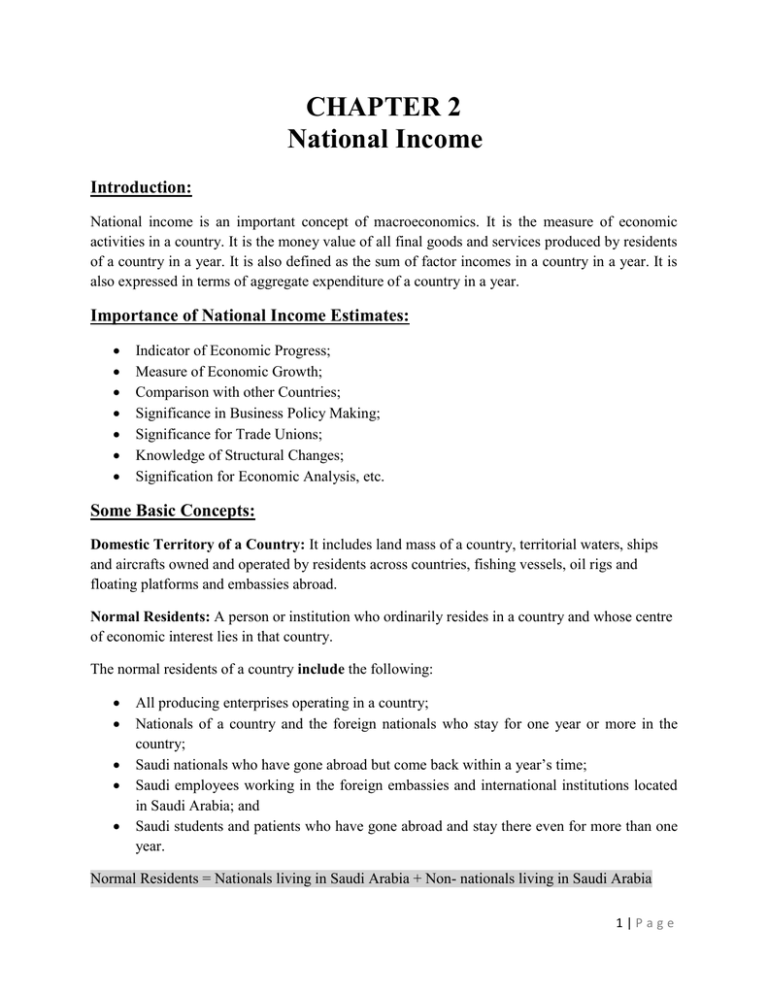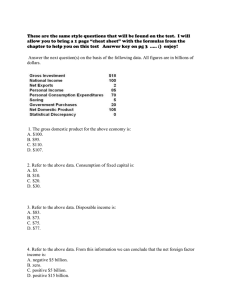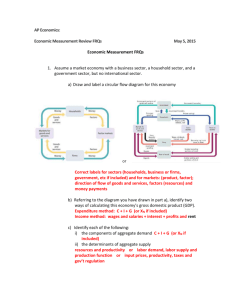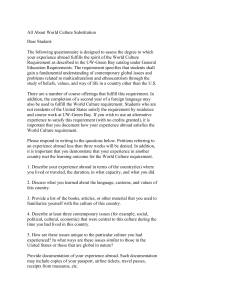chapter 2
advertisement

CHAPTER 2 National Income Introduction: National income is an important concept of macroeconomics. It is the measure of economic activities in a country. It is the money value of all final goods and services produced by residents of a country in a year. It is also defined as the sum of factor incomes in a country in a year. It is also expressed in terms of aggregate expenditure of a country in a year. Importance of National Income Estimates: Indicator of Economic Progress; Measure of Economic Growth; Comparison with other Countries; Significance in Business Policy Making; Significance for Trade Unions; Knowledge of Structural Changes; Signification for Economic Analysis, etc. Some Basic Concepts: Domestic Territory of a Country: It includes land mass of a country, territorial waters, ships and aircrafts owned and operated by residents across countries, fishing vessels, oil rigs and floating platforms and embassies abroad. Normal Residents: A person or institution who ordinarily resides in a country and whose centre of economic interest lies in that country. The normal residents of a country include the following: All producing enterprises operating in a country; Nationals of a country and the foreign nationals who stay for one year or more in the country; Saudi nationals who have gone abroad but come back within a year’s time; Saudi employees working in the foreign embassies and international institutions located in Saudi Arabia; and Saudi students and patients who have gone abroad and stay there even for more than one year. Normal Residents = Nationals living in Saudi Arabia + Non- nationals living in Saudi Arabia 1|Page The persons who will not be included in the category of normal residents of a country: Foreign nationals visiting the country for study tours, conferences, medical treatments, etc., and staying for a period less than one year (these persons, if they stay on for more than a year, will be considered as normal residents); Crew members of foreign vessels, businessmen and seasonal workers in the country if their stay is of less than a year (if they stay for more than one year, they will be considered as normal residents); International organizations (such as IMF, WTO, WHO, ILO, etc.) are not the normal residents of a country where they are located. They are residents of international area; Foreign national employees of international organizations, if their stay is of less than a year. However, Saudi nationals employed in the offices of these organizations situated in Saudi Arabia will be considered as normal residents of Saudi Arabia; and Officials, diplomats and members of the armed forces of a foreign country. Non- resident of a Country: if a Saudi national goes abroad and stays there for a period less than one year, he will remain normal resident of Saudi Arabia. But, if he stays there for more than one year he will be treated as non- resident of Saudi Arabia. Flow: It is quantity that can be measured over specific period of the time. Stock: It is quantity measureable at particular Point of the time. Accounting Year: The financial year which the flow of income in an economy is recorded. Capital formation: The surplus of the production over consumption in an accounting year which is further used for production. Final Goods: Goods which directly satisfies human wants. Intermediate Goods: Goods which are used in the production process to produce other goods. Per Capita Income: This is the average income of the citizens of a country obtained after dividing national income by living population. Subsidies: economic assistance given to the producing unit by the state for compensating the cost of product so that it is available to consumers at affordable prices. Factors of production/Primary Inputs/Economic Resources: Resources/goods which is used in the production process. For example land, labour, machines, power etc. 2|Page Circular Flow of Income: Flow of Income in a Two- sector Economy: Flow of Income in a Three- sector Economy (Introduction of Saving and Investment in the Flow of Income): 3|Page Flow of Income in a Four- sector Economy (Introduction of Foreign Trade in the Flow of Income): Some Concepts of National Income and Related Aggregates: The important concepts related to national income are: Gross Domestic Product at Market Price (GDPMP); Gross Nation Product at Market Price (GNPMP); Net Domestic Product at Market Price (NDPMP); Net Nation Product at Market Price (NNPMP); Gross Domestic Product at Factor Cost (GDPFC); Gross Nation Product at Factor Cost (GNPFC); Net Domestic Product at Factor Cost (NDPFC); Net Nation Product at Factor Cost (NNPFC); Private Income; Personal Income; Personal Disposable Income; Gross Domestic Product at Market Price (GDPMP): Gross Domestic Product (GDPMP) is the market value of all final goods and services produced within domestic territory of the country during a year. Features of GDPMP: It includes only final goods and services produced in the domestic territory of a country; 4|Page It includes consumption of fixed capital (depreciation); It is estimated at the prevailing prices. Gross Nation Product at Market Price (GNPMP): Gross National Product at market price is Gross Domestic Product at market price plus net factor income from abroad. GNPMP is the money value of all final goods and services produced in the domestic territory of a country during a year plus Net factor income from abroad. i.e., GNPMP = GDPMP + NFIA Where, GNPMP = Gross National Product at market price GDPMP= Gross Domestic Product at market price NFIA= Net factor income from abroad Net Factor Income from Abroad (NFIA): Net factor income from abroad is the difference between the income received from abroad for rendering factor services by the normal residents of the country to the rest of the world and income paid for the factor services rendered by nonresidents in the domestic territory of a country. Net Domestic Product at Market Prices (NDPMP): Net Domestic Product at market prices is the net market value of all the final goods and services produced in domestic territory of a country during a year. Net market value of the goods is equal to the market value of goods minus depreciation. NDPMP = GDPMP – D (or CCA) Where, NDPMP= Net Domestic Product at market prices GDPMP= Gross Domestic Product at market price D = Depreciation CCA= Capital Consumption Allowances Net National Product at Market Price (NNPMP): Net National Product at Market Prices is the net market value of all the final goods and services produced by the normal residents of a country during a year. NNPMP = GNPMP – D Where, NNPMP = Net National Product at Market Prices GNPMP = Gross National Product at market price D = Depreciation 5|Page Gross Domestic Product at Factor Cost (GDPFC): It is the sum of net value added at factor cost by all the producers in the domestic territory of a country and the consumption of fixed capital during an accounting year. i.e., GDPFC = Domestic Factor Income + Consumption of Fixed Capital GDPFC = GNPMP – IT + S Gross National Product at Factor Cost (GNPFC): It is the difference between the GNPMP and net indirect taxes. It is the sum of net domestic factor income, consumption of fixed capital and net factor income from abroad. Symbolically, GNPFC = GNPMP – IT + S GNPFC = Domestic Factor Income + NFIA + Consumption of fixed capital. Net Domestic Product at Factor Cost (NDPFC): Net domestic income is the income generated in the form of wages, rent, interest and profit in the domestic territory of a country by all the producers (normal and non- normal residents) in an accounting year. In other words, NDPFC = NDPMP – IT + S Where; IT = Indirect Taxes; and S = Subsidies. Net Indirect Tax: The difference between IT and S is known as net indirect tax. Net National Product at Factor Cost (NNPFC): Net National Product at the factor cost is the sum total of net value added at factor cost by all the normal residents producer enterprises of a country during a year. Symbolically, NNPFC = NDPFC + NFIA It is also expressed as the sum of domestic factor income and net factor income from abroad. i.e., NNPFC = Net Domestic Income + NFIA Net National Product at Factor Cost (NNPFC) is also known as National Income. Personal Income: Personal income is sum of all kinds of income received by the individuals from all sources. Private Income: It refers to the income which accrues to individuals from whatsoever source, within the domestic territory of a country and abroad. 6|Page Distinction between Private Income and Personal Income: Private income includes all the payments which accrue to individuals from whatever sources while personal income includes only those payments which are actually received by the individuals. Personal Disposable Income: It refers to that part of personal income which is actually available to households for consumption and saving. In other words, Personal Disposable Income = Personal Income – (Direct Taxes + Fines, Fees, etc. + Social Security Contributions by Employees) Net National Disposable Income: It is the sum of national income, net indirect taxes and other current transfers from the rest of the world. In other words, Net National Disposable Income = National Income + Net Indirect Taxes + Net Capital Transfers from the rest of the World Per Capita Income (PCI): It is the average income of the normal residents of a country. Symbolically, PCI = 𝑁𝑎𝑡𝑖𝑜𝑛𝑎𝑙 𝐼𝑛𝑐𝑜𝑚𝑒 (𝑁𝑁𝑃𝑎𝑡 𝐹𝑎𝑐𝑡𝑜𝑟 𝐶𝑜𝑠𝑡) 𝑃𝑜𝑝𝑢𝑙𝑎𝑡𝑖𝑜𝑛 Real Income: The income measured in physical term or in terms of the quantity of goods and services. It is calculated at some base year. Nominal income: The income measured in term of current price. GDP Deflator: It is nominal GDP (current price) divided by real GDP (base year price). GDP Deflator = 𝑁𝑜𝑚𝑖𝑛𝑎𝑙 𝐺𝐷𝑃 𝑅𝑒𝑎𝑙 𝐺𝐷𝑃 × 100 Measurement of National Income National income worked as important indicators to measure the level of economic growth and welfare of the country. National income data facilitate the formulation of plans and fixing the targets of development. National incomes also narrate the picture of saving, investment, distribution of national income, consumption and employment level of the country. For this overall these aspects we need national income and allied estimates. Methods of Measurement of National Income There are three methods of the measurement of the national income. They are as follows: 1. Value Added Method or Product Method 2. Income Method or Factor income in production process 7|Page 3. Expenditure Method VALUE ADDED METHOD OR PRODUCT METHOD The economy consists of either public or private enterprises. The enterprises contribute to the production with the help of given factors of production. In the economy the produced goods are useful for producers and individuals or we can say that they are either consumer goods or the producer goods. In the same way there are various people who are not directly producing. But without providing their services the economy cannot run. For example the services of doctor, teachers, Police, bank services etc. are necessary for economic development. Those people who are providing these services are paid in terms of the wages and salaries. Therefore , Value added method or product method of the estimation of the national income states that if we add all the money value of the final goods and services in domestic territory of the in an accounting year time gives us Gross Domestic Product at market prices. Steps for the Estimation of National Income by Value Added or Product Method 1) Estimating the value of Gross Domestic Product of the different sectors of an economy. The producing sectors of an economy divided into three parts A. Primary Sector B. Secondary sector and C. Tertiary sector 2) Determining the cost of Materials and services provided by the sectors 3) Determining the net value added of the domestic product and 4) Adding the factor income from abroad Precautions while estimating National Income through Value Added Method A. Net Increase in stocks should be included. B. Own account production of fixed assets by all the producer enterprises should be included. C. Non- marketed goods and services for self-consumption should not be included. D. Imputed rent of owner occupied houses should be properly counted and included. E. Sales and purchase of second hand goods should not be included. F. The brokerage or commission of second hand should be included because it is productive services rendered by them. G. Trading of stocks and bonds should not count in the estimation of national income because it does not represent the production of new assets. INCOME METHOD According to the income method, national income is estimated by adding incomes earned by all factors of production for their factor services during a year. The factor services include land, 8|Page labour, capital and enterprises. These factor services received the income against their services. The factors income distributed as follow: Factors of Production 1.Land 2.Labour 3.Capital 4.Enterprises Steps of Income Method I. II. III. Factors Income 1. Rent 2.Wages or Salaries 3.Interest 4. Profit Identifying the producer enterprises which employ factors of production This is the first step. All the producer enterprises are divided into three main sectors: primary, secondary and tertiary sector. Classification of Factor Incomes Factor incomes are generally classified into three groups A. Compensation to the employees B. Operating surplus (Rent +Interest+ Profit) and C. Mixed Income of the self employed Estimating Factor Payments— Payment made by different individual enterprises to the factors of production for rendering factor services is known as factor payments. Adding the factor payments by all enterprises in an individual sector, we get factor payment of that sector. By adding the incomes paid out to all the sectors of the domestic territory of the country, we get domestic factor income or the national income. Precautions while estimating National Income through Income Method A. All government expenditure on transfer payments, such as Unemployment benefits, old age Pensions, scholarships etc. should not be included. This is because they are received without rendering any productive services. B. Value of imputed rent owner-occupied houses should be included. C. Incomes earned through illegal activities like smuggling, tax evasion etc. should not be included. D. Windfall gains like lottery income should not be included. E. Money received for sale and purchase of second hand goods and bonds and share should not be included in factor income. EXPENDITURE METHOD According to the expenditure method, the gross domestic product (GDP) is the sum total of all final expenditure on various goods and services within domestic territory of the country, during a year. The main components of the final expenditure are as follows; I. Private Final Consumption Expenditure(C) 9|Page II. III. IV. Investment Expenditure (I) Government purchase of goods and services(G) Net Exports (X-M) Where, X for exports and M for Imports Mathematically the expenditure method to calculate the national income written as Y= C+I+G+(X-M) + Net Factor Income from Abroad Where, Y is the National Income C is the Private Consumption Expenditure I is the Investment Expenditure G is the Government Purchases of the goods and services X-M is the net Exports Precautions of Expenditure Method A. Expenditure on second hand goods should not included B. Expenditure on bonds and shares should not be included C. All government expenditure on transfer payments, such as Unemployment benefits, old age Pensions, scholarships etc. should not be included. D. Expenditure on all intermediate goods and services should not be included. Formula: National Income Accounting: GDPMP = C + I + G GNPMP = GDPMP + NFIA NDPMP = GDPMP – D (or CCA) NNPMP = GNPMP – D GDPFC = Domestic Factor Income + Consumption of Fixed Capital GDPFC = GDPMP – IT + S GNPFC = GNPMP – IT + S GNPFC = Domestic Factor Income + NFIA + Consumption of fixed capital. NDPFC = NDPMP – IT + S NNPFC = NDPFC + NFIA NNPFC = Net Domestic Income + NFIA 10 | P a g e Personal Income = Private Income – Corporate Taxes – Corporate Savings Personal Disposable Income = Personal Income – (Direct Taxes + Fines, Fees, etc. + Social Security Contributions by Employees) Net National Disposable Income = National Income + Net Indirect Taxes + Net Capital Transfers from the rest of the World Personal Saving = Personal Disposable Income – Personal Consumption Expenditure Gross Domestic Saving = Personal Savings + Private Corporate Savings + Public Savings. PCI = 𝑁𝑎𝑡𝑖𝑜𝑛𝑎𝑙 𝐼𝑛𝑐𝑜𝑚𝑒 (𝑁𝑁𝑃𝑎𝑡 𝐹𝑎𝑐𝑡𝑜𝑟 𝐶𝑜𝑠𝑡) GDP Deflator = 𝑃𝑜𝑝𝑢𝑙𝑎𝑡𝑖𝑜𝑛 𝑁𝑜𝑚𝑖𝑛𝑎𝑙 𝐺𝐷𝑃 𝑅𝑒𝑎𝑙 𝐺𝐷𝑃 × 100 Questions for Review Multiple Choice Questions with Answer: 1. The market value of all final goods and services produced within domestic territory of the country during a year is known as------------a. GDPMP b. GDPFC c. GNPMP d. GNPFC 2. The money value of all final goods and services produced in the domestic territory of a country during a year plus Net factor income from abroad is called-----------a. GDPMP b. GDPFC c. GNPMP d. GNPFC 3. The difference between the income received from abroad for rendering factor services by the normal residents of the country to the rest of the world and income paid for the factor services rendered by nonresidents in the domestic territory of a country is known as------a. Net Factor Income from Abroad b. Capital Consumption Allowances c. Depreciation d. None of these. 4. The difference between indirect tax and subsidy is known as------------a. Net Factor Income from Abroad b. Capital Consumption Allowances c. Depreciation d. Net Indirect Tax. 11 | P a g e 5. Net National Product at Factor Cost (NNPFC) is also known as-----------a. Net Factor Income from Abroad b. National Income c. National cost d. Net Indirect Tax. 6. That part of personal income which is actually available to households for consumption and saving is called----------a. National Disposable Income b. Personal Disposable Income c. Personal Income d. None. 7. Real and nominal income is calculated respectively at------------a. Current price and Constant Price b. Constant price and Current price c. Current price and Current price d. Constant price and Constant price. 8. GDP Deflator is equal to----------𝑁𝑜𝑚𝑖𝑛𝑎𝑙 𝐺𝐷𝑃 𝑎. c. 𝑅𝑒𝑎𝑙 𝐺𝐷𝑃 𝑁𝑜𝑚𝑖𝑛𝑎𝑙 𝐺𝑁𝑃 𝑅𝑒𝑎𝑙 𝐺𝑁𝑃 𝑅𝑒𝑎𝑙 𝐺𝐷𝑃 b. 𝑁𝑜𝑚𝑖𝑛𝑎𝑙 𝐺𝐷𝑃× 100 × 100 × 100 d. 𝑁𝑜𝑚𝑖𝑛𝑎𝑙 𝑁𝐷𝑃 𝑅𝑒𝑎𝑙 𝑁𝐷𝑃 × 100 9. Sum of all kinds of income received by the individuals from all sources is called--------a. Personal Income b. Private Income c. Personal Disposable Income d. None 10. GNPMP is equal to a. GDPMP + NFIA c. GDPMP – D Ques Ans 1 a 2 c 3 a b. GDPMP - NFIA d. None 4 d 5 b 6 b 7 b 8 a 9 a 10 a Write T for True and F for False against each of the following statements: 1. GNPMP is the money value of all final goods and services produced in the domestic territory of a country during a year. 2. Gross Domestic Product (GDPMP) is the market value of all final goods and services produced within domestic territory of the country during a year. 3. GNPMP = GDPMP + NFIA 4. NDPMP = GDPMP – D (or CCA) 5. NNPMP = GNPMP – D 6. Net National Product at Factor Cost (NNPFC) is also known as National Income. 12 | P a g e 7. The difference between IT and S is known as net indirect tax. 8. GDPMP does not include consumption of fixed capital (depreciation). 1 F Ques Ans 2 T 3 T 4 T 5 T 6 T 7 T 8 F Matching Test: Factors of Production- I 1. Land 2. Labour 3. Capital 4. Enterprises 1 A Match- I Match- II A. B. C. D. Factors Income- II A. Rent B. Wages or Salaries C. Interest D. Profit 2 B Match- I GDPMP + NFIA GNPMP – IT + S GNPMP – D NDPFC + NFIA A 2 Match- I Match- II 3 C 4 D Match- II 1. 2. 3. 4. B 1 GNPFC GNPMP NNPFC NNPMP C 4 D 3 Questions with Answer: Question: What do you understand by the term national income? Answer: It is the money value of all final goods and services produced by residents of a country in a year. It is also defined as the sum of factor incomes in a country in a year. It is also expressed in terms of aggregate expenditure of a country in a year. Question: What is the importance of national income accounting in an economy? Answer: Followings are the points which shows the importance of national income accounting: Indicator of Economic Progress; Measure of Economic Growth; Comparison with other Countries; 13 | P a g e Significance in Business Policy Making; Significance for Trade Unions; Knowledge of Structural Changes; Signification for Economic Analysis, etc. Question: What do you understand by the term domestic territory of a country? Answer: It includes land mass of a country, territorial waters, ships and aircrafts owned and operated by residents across countries, fishing vessels, oil rigs and floating platforms and embassies abroad. Question: What do you mean by normal resident? Answer: A person or institution who ordinarily resides in a country and whose centre of economic interest lies in that country is called normal resident. The normal residents of a country include the following: All producing enterprises operating in a country; Nationals of a country and the foreign nationals who stay for one year or more in the country; Saudi nationals who have gone abroad but come back within a year’s time; Saudi employees working in the foreign embassies and international institutions located in Saudi Arabia; and Saudi students and patients who have gone abroad and stay there even for more than one year. Normal Residents = Nationals living in Saudi Arabia + Non- nationals living in Saudi Arabia Question: What do you understand by non- resident of a country? Answer: if a Saudi national goes abroad and stays there for a period less than one year, he will remain normal resident of Saudi Arabia. But, if he stays there for more than one year he will be treated as non- resident of Saudi Arabia. Question: What is capital formation? Answer: The surplus of the production over consumption in an accounting year which is further used for production is called capital formation. Question: What are final goods? Answer: Goods which directly satisfies human wants are called final goods. Question: What are intermediate goods? 14 | P a g e Answer: Goods which are used in the production process to produce other goods are called intermediate goods. Question: What is Gross Domestic Product at Market Price (GDPMP)? Answer: Gross Domestic Product (GDPMP) is the market value of all final goods and services produced within domestic territory of the country during a year. Question: What is the features of GDPMP? Answer: the main features of GDPMP are: It includes only final goods and services produced in the domestic territory of a country; It includes consumption of fixed capital (depreciation); It is estimated at the prevailing prices. Question: What is Gross Nation Product at Market Price (GNPMP)? Answer: Gross National Product at market price is Gross Domestic Product at market price plus net factor income from abroad. GNPMP is the money value of all final goods and services produced in the domestic territory of a country during a year plus Net factor income from abroad. i.e., GNPMP = GDPMP + NFIA Where, GNPMP = Gross National Product at market price GDPMP= Gross Domestic Product at market price NFIA= Net factor income from abroad Question: What do you understand by Net Factor Income from Abroad (NFIA)? Answer: Net factor income from abroad is the difference between the income received from abroad for rendering factor services by the normal residents of the country to the rest of the world and income paid for the factor services rendered by nonresidents in the domestic territory of a country. Question: What is Net Domestic Product at Market Prices (NDPMP)? Answer: Net Domestic Product at market prices is the net market value of all the final goods and services produced in domestic territory of a country during a year. Net market value of the goods is equal to the market value of goods minus depreciation. NDPMP = GDPMP – D (or CCA) 15 | P a g e Where, NDPMP= Net Domestic Product at market prices GDPMP= Gross Domestic Product at market price D = Depreciation CCA= Capital Consumption Allowances Question: What is Net National Product at Market Price (NNPMP): Net National Product at Answer: Market Prices is the net market value of all the final goods and services produced by the normal residents of a country during a year. NNPMP = GNPMP – D Where, NNPMP = Net National Product at Market Prices GNPMP = Gross National Product at market price D = Depreciation Question: What is Gross Domestic Product at Factor Cost (GDPFC)? Answer: It is the sum of net value added at factor cost by all the producers in the domestic territory of a country and the consumption of fixed capital during an accounting year. i.e., GDPFC = Domestic Factor Income + Consumption of Fixed Capital GDPFC = GNPMP – IT + S Question: What is Gross National Product at Factor Cost (GNPFC)? Answer: It is the difference between the GNPMP and net indirect taxes. It is the sum of net domestic factor income, consumption of fixed capital and net factor income from abroad. Symbolically, GNPFC = GNPMP – IT + S GNPFC = Domestic Factor Income + NFIA + Consumption of fixed capital. Question: What is Net Domestic Product at Factor Cost (NDPFC)? Answer: Net domestic income is the income generated in the form of wages, rent, interest and profit in the domestic territory of a country by all the producers (normal and nonnormal residents) in an accounting year. In other words, NDPFC = NDPMP – IT + S 16 | P a g e Where; IT = Indirect Taxes; and S = Subsidies. Question: What is Net Indirect Tax? Answer: The difference between IT and S is known as net indirect tax. Question: What is Net National Product at Factor Cost (NNPFC)? Answer: Net National Product at the factor cost is the sum total of net value added at factor cost by all the normal residents producer enterprises of a country during a year. Symbolically, NNPFC = NDPFC + NFIA It is also expressed as the sum of domestic factor income and net factor income from abroad. i.e., NNPFC = Net Domestic Income + NFIA Net National Product at Factor Cost (NNPFC) is also known as National Income. Question: What is Personal Income? Answer: Personal income is sum of all kinds of income received by the individuals from all sources. Question: What is Private Income? Answer: It refers to the income which accrues to individuals from whatsoever source, within the domestic territory of a country and abroad. Question: What is difference between Private Income and Personal Income? Answer: Private income includes all the payments which accrue to individuals from whatever sources while personal income includes only those payments which are actually received by the individuals. Question: What is Personal Disposable Income? Answer: It refers to that part of personal income which is actually available to households for consumption and saving. In other words, Personal Disposable Income = Personal Income – (Direct Taxes + Fines, Fees, etc. + Social Security Contributions by Employees) 17 | P a g e Question: What is Net National Disposable Income? Answer: It is the sum of national income, net indirect taxes and other current transfers from the rest of the world. In other words, Net National Disposable Income = National Income + Net Indirect Taxes + Net Capital Transfers from the rest of the World Question: What is Per Capita Income (PCI)? Answer: It is the average income of the normal residents of a country. Symbolically, PCI = 𝑁𝑎𝑡𝑖𝑜𝑛𝑎𝑙 𝐼𝑛𝑐𝑜𝑚𝑒 (𝑁𝑁𝑃𝑎𝑡 𝐹𝑎𝑐𝑡𝑜𝑟 𝐶𝑜𝑠𝑡) 𝑃𝑜𝑝𝑢𝑙𝑎𝑡𝑖𝑜𝑛 Question: What is Real Income? Answer: The income measured in physical term or in terms of the quantity of goods and services. It is calculated at some base year. Question: What is Nominal income? Answer: The income measured in term of current price is called nominal income. Question: What is GDP Deflator? Answer: It is nominal GDP (current price) divided by real GDP (base year price). GDP Deflator = 𝑁𝑜𝑚𝑖𝑛𝑎𝑙 𝐺𝐷𝑃 𝑅𝑒𝑎𝑙 𝐺𝐷𝑃 × 100 Question: What are the methods of measurement of national income? Answer: There are three methods of the measurement of the national income: 4. Value Added Method or Product Method 5. Income Method or Factor income in production process 6. Expenditure Method Formula: National Income Accounting GDPMP = C + I + G GNPMP = GDPMP + NFIA NDPMP = GDPMP – D (or CCA) NNPMP = GNPMP – D 18 | P a g e GDPFC = Domestic Factor Income + Consumption of Fixed Capital GDPFC = GDPMP – IT + S GNPFC = GNPMP – IT + S GNPFC = Domestic Factor Income + NFIA + Consumption of fixed capital. NDPFC = NDPMP – IT + S NNPFC = NDPFC + NFIA NNPFC = Net Domestic Income + NFIA Personal Income = Private Income – Corporate Taxes – Corporate Savings Personal Disposable Income = Personal Income – (Direct Taxes + Fines, Fees, etc. + Social Security Contributions by Employees) Net National Disposable Income = National Income + Net Indirect Taxes + Net Capital Transfers from the rest of the World Personal Saving = Personal Disposable Income – Personal Consumption Expenditure Gross Domestic Saving = Personal Savings + Private Corporate Savings + Public Savings. PCI = 𝑁𝑎𝑡𝑖𝑜𝑛𝑎𝑙 𝐼𝑛𝑐𝑜𝑚𝑒 (𝑁𝑁𝑃𝑎𝑡 𝐹𝑎𝑐𝑡𝑜𝑟 𝐶𝑜𝑠𝑡) 𝑃𝑜𝑝𝑢𝑙𝑎𝑡𝑖𝑜𝑛 GDP Deflator = 𝑁𝑜𝑚𝑖𝑛𝑎𝑙 𝐺𝐷𝑃 𝑅𝑒𝑎𝑙 𝐺𝐷𝑃 × 100 Question: Suppose a country produces four goods: rice, cloth, cement and cars. The production of the four commodities in the year 2013- 14 was 1000 units, 5000 units, 2000 units and 500 units respectively. The per unit price of the four commodities is SR 10, SR 20, SR 50 , and SR 2,00,000 respectively. Find out the GDP at market prices. Solution: S. Commodity Quantity No. (Units) 1. Rice 1000 2. Cloth 5000 3. Cement 2000 4. Car 500 Total Money Value in SR (GDPMP) = Price per unit (SR) 10 20 50 20,00,000 Gross Money Value (SR) 10,000 1,00,000 1,00,000 10,00,00,000 10,02,10,000 19 | P a g e Question: Suppose the gross domestic product at market prices of Saudi Arabia in 2012- 13 was SR 85,000 crores and net factor income from abroad was (-) SR 430 crores. Calculate GNPMP. Solution: GNPMP = GDPMP + NFIA = 85,000 + (- 430) = SR 84,570 crores. Question: Suppose we are provided with the following information: (i) (ii) GNPMP = SR 35,800 Crores Consumption of fixed capital = SR 1,670 Find out Net National Product at market price. Solution: NNPMP = GNPMP – Consumption of fixed capital = 35,800 – 1,670 = SR 34,130 Crores. Question: Given the following data, calculate net domestic product at market prices: (i) (ii) (iii) Gross National Product at market prices = SR 85,000 Crores; Consumption of fixed capital = SR 3,000 Crores Net factor income from abroad = SR 2,000 Crores. Solution: NDPMP = GDPMP- Consumption of fixed capital = (GNPMP – Net factor income from abroad) - Consumption of fixed capital = (85,000 – 2,000) – 3,000 = SR 80,000 Crores. Question: Given the following information, calculate net domestic product at factor cost: (i) (ii) (iii) Net domestic product at market prices = SR 25,000 Crores Indirect taxes = SR 1500 Crores Subsidies = SR 500 Crores. Solution: NDPFC = NDPMP – IT +S = 25000 – 1500 + 500 = SR 24000 Crores. Question: Given the following information about an economy, calculate net domestic product at factor cost: 20 | P a g e (i) (ii) (iii) (iv) Gross domestic product at market prices = SR 12000 Crores Consumption of fixed capital = SR 1500 Crores Subsidies = SR 300 Crores Indirect taxes = SR 1000. Solution: NDPFC = NDPMP – IT + S = (GDPMP – Consumption of fixed capital) – IT + S = (12000 – 1500) + 1000 + 300 = 9500 + 1300 = SR 10800 Crores Question: Given the following data, calculate GDPFC: (i) (ii) Net domestic product at factor cost = SR 25000 Cr Consumption of fixed capital = SR 3000 Cr Solution: GDPFC = NDPFC + Consumption of fixed capital = 25000 + 3000 = SR 28000 Cr. Question: Given the following information, calculate GDPFC: (i) (ii) (iii) (iv) (v) NNPMP = SR 3200 Cr NFIA = SR 200 Cr Consumption of fixed capital = SR 1000 Cr Indirect taxes = SR 500 Cr Subsidies = SR 300 Cr Solution: GDPFC = GDPMP – IT + S = (NNPMP + Consumption of fixed capital - NFIA) – IT + S = (3200 + 1000 - 200) – 500 + 300 = 4000 – 500 + 300 = SR 3700 Cr Question: Suppose the NDPFC of an economy is SR 22000 crores and the net factor income from abroad is (-) SR 300 crores. Find out net national product at factor cost (NNPFC). Solution: NNPFC = NDPFC + NFIA = 22000 + (-) 300 = SR 1900 Crores 21 | P a g e Question: Given the following information about an economy, calculate Net national product at factor cost: (i) Wages and salaries = SR 6000 Crores (ii) Rent = SR 800 Crores (iii) Interest = SR 200 Crores (iv) Profit = SR 1500 Crores (v) Net factor income from abroad = SR (-) 100 Crores Solution: NNPFC = Net Domestic Income + NFIA = (Wages and Salaries + Rent + Interest + Profit) + NFIA = (6000 + 800 + 200 + 1500) + (-100) = 8500 – 100 = SR 8400 Crores. Question: Suppose, the national income of a country is SR 10,00,000 million and the population is 100 million. Find out the per capita income of that country. Solution: Per Capita Income (PCI) = 𝑁𝑎𝑡𝑖𝑜𝑛𝑎𝑙 𝐼𝑛𝑐𝑜𝑚𝑒 𝑃𝑜𝑝𝑢𝑙𝑎𝑡𝑖𝑜𝑛 = 10,00,000 100 = SR 10,000 22 | P a g e






